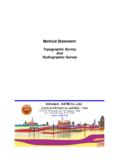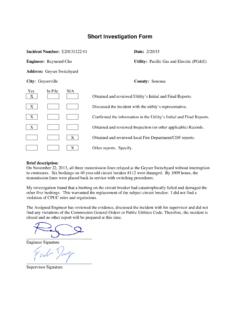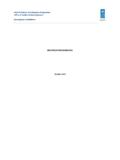Transcription of Soil Investigation - i-astm.com
1 Method Statement FOR. Soil Investigation PREPARED BY JUNE 2010. Infratech ASTM CO., LTD. TABLE OF CONTENTS. Chapter Title Page Table of Contents ..1. List of 2. List of 2. List of 2. INTRODUCTION AND BACK GROUND OF THE PROJECT .. 3. SCOPE OF WORK .. 3. FIELD Investigation AND BOUNDARY SURVEY .. 3. General .. 3. Boring and Sampling . 4. Groundwater ..4. Field permeability Test ..4. Soil Resistivity Test ..5. Test Pit .5. Down Hole Seismic Test .5. Dutch Cone Penetration Test ..5. Site Boundary Survey LABORATORY TEST ..6. Unconfined Compression test . 6. Atterberg Limits . 6. Particle Size Analysis .. 6. Unit Weight and Water Content Determination . 7. Oedometer test ..7. Compaction Test and CBR Test 7. Water Analysis .7. REPORT ..8. Figures Appendix Tables 1. Infratech ASTM CO., LTD. List of Appendix Appendix A Sample of Soil Boring Log data sheet Appendix B Sample of Summary of general laboratory test data sheet Appendix C Sample of Pile calculation data sheet Appendix D Sample of Shallow Foundation Bearing Capacity Analysis Appendix E Sample of Prediction of long term settlement calculation List of Table Table 1 Sample of Unconfined Compression Test data sheet Table 2 Sample of Atterberg Limit Test data sheet Table 3 Sample of Sieve Analysis Test data sheet Table 4 Sample of Unit Weight data sheet Table 5 Sample of Water content Test data sheet Table 6 Sample of Consolidation Test data sheet Table 7 Sample of Field Permeability test data sheet Table 8 Sample of soil resistivity test data sheet Table 9 Sample of down hole seismic test data sheet Table 10 Sample of Dutch cone penetration test data sheet Table 11 Sample of compaction and CBR
2 Test data sheet Table 12 Sample water analysis test data sheet 2. Infratech ASTM CO., LTD. INTRODUCTION AND BACK GROUND OF THE PROJECT. This method statement will summarizes the procedure on the subsoil Investigation works and boundary survey to be conducted by Infratech ASTM Company Limited for the construction .. SCOPE OF WORK. The scope of work for the geotechnical consultancy services of the project are summarized as follows: Soil boring, field testing and carrying out sufficient in-situ testing and sampling. Laboratory testing of obtained samples to determine the properties of the subsoil. Determination of geotechnical parameters required for foundation analyses. Carrying out engineering analyses for foundation design. FIELD Investigation . General The Investigation program included drilling boreholes and collecting soil samples at desired intervals for subsequent observation and laboratory testing.
3 The Investigation program will consist of soil boring and sampling at desired intervals for subsequent observation and laboratory testing to determine the capacity of pile foundation economically and safely. Boring and Sampling The boreholes will be made by the rotary drilling machine. Undisturbed sample will be taken in the soft and medium clay at , , and m depths and at m intervals thereafter using a thin-walled sampler with dimensions conforming to standard sampling tubes specification (ASTM D 1587). Disturbed samples for very stiff clay to hard clay layer will be collected during Standard Penetration Testing at m intervals. (ASTM D 1586). The borings shall be drilled vertically through soil approximately 30 meters deep or stop in firm layer when SPT N-value is greater than 50 blows/ft. Accuracy of bore hole position will be not more than m. in horizontal direction and in vertical direction.
4 Standard Penetration Testing Standard Penetration Tests (SPT) will be carried out to provide an indication of the density and/or consistency of the ground and to obtain disturbed samples for visual inspection and laboratory testing and classification. The results of the tests will be given on the boring logs in Appendix A and will 3. Infratech ASTM CO., LTD. be expressed as an N value. The N value is defined as the blow-count for 12 (300mm) penetration recorded after the seating drive of 15 cm. In the case of premature refusal conditions, the number of blows for a recorded penetration (including the seating drive) is noted. In SPT testing, the rope-and-pulley (R-P) method will be used. This consisted of a hollow cylindrical mass sliding over a steel rod. It is operated by lifting the mass with a rope over a cat head. At the instant the mass reached the required height (760 mm), the mass will be released manually driving the split spoon into the soil.
5 Disturbed samples collected from the split-spoon sampler during Standard Penetration Test will be visually inspected before storing in a polyethylene bag for laboratory testing. A. graphical representation of the changes in the soil strata, water levels and SPT N values will be given in the boring logs. Groundwater Measurement Groundwater is one element that affects in the stability and foundation analyses. The groundwater level was measured 24 hours after completion of the borehole. However, the low permeability of the soil will mean that the water level in the borehole is controlled more by drilling fluid rather than by the ground water itself. Significant fluctuations in the location of ground water table should be anticipated throughout the year, depending upon the amount of precipitation, evaporation and surface runoff. Field Permeability Test Permeability test of soil in the field will be performed at the depth of 2,4,6,8 and 10 m.
6 By constant head method. Soil Resistity Test (Provisional). The purpose of this test is to investigate for the need of cathode protection and to have data necessary for the design of an adequate grounding system. The soil Resistivity measurement shall be carried out in accordance with IEEE 81 standard . Guide for Measuring Earth Resistivity, Ground Impedance and Earth Surface Potentials of a Ground System . The measurement shall be done using Wenner Four Points Method with equal test rods spacing. The area to be measured shall be the power block area of power plant, terminal substation and switchyard. Before carrying out the measurement, the rectangular grid shall be drawn for the testing areas with mesh spacing at approximately 5-10 m. The measurement shall be made at every intersection point of grid lines. The measurement at any point shall be done for two directions, one from the measured point along the direction from east to west and another shall be from the measured point along the direction from north to south.
7 The measurement at any point shall consist of the measured data at the varying space between test rods for the following distance; , , , , , m. For each area of measurement, the results of measurement shall be shown in the table for each point of measurement for each direction and every designated space of measurement. The measured resistivity data shall be averaged for each of the same spacing of measured data. The overall averaged resistivity of each area shall also be reported. Test Pit (Provisional). Test pit shall be preformed 3 points of 1x1m size 3 m deep, by mean of hand excavation. Bulk sample taken from the test pits of not less than 50 kg each shall be sent to test at laboratory for compaction and CBR test. 4. Infratech ASTM CO., LTD. Seismic down hole test (Provisional). The down hole Test is a method which determines soil stiffness properties by analyzing direct compression and shear waves along a borehole.
8 Seismic down hole test shall be performed at meter intervals to the depth of m. or to the same depth of soil bore hole (where SPT N-value is greater than 50 blows/ft). The test shall be intended to collect shear wave velocity information that will be used in dynamic analysis. The testing location shall be located in the power block area and close to expected location of Steam Turbine foundation. Dutch Cone Penetration Test (Provisional). Dutch cone penetration test shall be preformed depth 30m. or to the depth when the total resistant of the cone penetrometer reach tons. The test shall be carried out in accordance with the ASTM D 3441. The cone penetration test shall be consists of pushing into the soil, at a sufficiently slow rate, a series of cylindrical rods with a conical tip at the base for measuring the cone resistance and friction resistance every 20 cm intervals.
9 LABORATORY TESTING. Geotechnical laboratory tests will be performed on the soil samples to classify soil and to determine their engineering characteristics. All laboratory tests will be conducted in accordance with ASTM Standards. The soils will be also classified based on the Unified Soil Classification System (USCS). Unconfined Compression Tests Unconfined compression test will be conducted in accordance with ASTM D2166. The tests will be performed by compressing cylindrical samples to failure. Failure generally occurs when the greatest ratio of shear stress to shear strength occurs. The cohesion (c) of the sample is taken as half the unconfined compressive strength. Sample of test results and data sheet has been shown in Table 1. Atterberg Limits Atterberg limits will be determined (ASTM D 4318) on representative soil samples of cohesive soils. The Atterberg limits refer to arbitrarily defined boundaries between the liquid and plastic states, and between the plastic and brittle states of grained soils, expressed as water content, in percentage.
10 The liquid limit is the water content at which a part of soil placed in a standard cup, cut by a standard grooving tool, will flow together at the base of the groove when the cup is subjected to 25 standard shocks. The one-point liquid limit test is usually carried out and distilled water may be added during soil mixing to achieve a desired consistency. Sample of test results and data sheet has been shown in Table 2. 5. Infratech ASTM CO., LTD. Particle Size Analysis Particle size analysis will be performed by means of sieving (ASTM D 422). For oven-dry materials, sieving is carried out for particles that are being retained on a mm sieve. In sieve analysis, the mass of soil retained on each sieve is determined and expressed as a percentage of the total mass of the sample. The particle size is plotted on a logarithmic scale so that two soils having the same degree of uniformity are represented by curves of the distribution plot.








